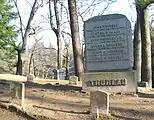Tag:historic=cemetery
 |
| Description |
|---|
| A cemetery with historic significance. |
| Group: historic |
| Used on these elements |
| Useful combination |
| Status: in use |
| Tools for this tag |
|
historic= is added to landuse=cemetery to denote a cemetery with historic significance. To know when a feature (e.g., a cemetery) has historic significance, see historic=*.
Some historic cemeteries continue to operate for new burials. Others may have stopped accepting new burials and are preserved only as a historical site. Life cycle prefixes could be used where appropriate.
Discussion
As of 8 February 2021 there were 1609 matches for the combination of tagging landuse=cemetery + historic=* in Taginfo. historic= has been used 475 times (445 on ways, 22 on nodes and 8 on relations), 405 uses in combination with landuse=cemetery, mainly in Europe (notably Poland and Germany). Also in North America (mainly the United States) and Australia.
This pattern of use suggests that mappers have used this tag as a complementary tag to landuse=cemetery to indicate that this feature is a historic cemetery. The alternative for mapping a historic cemetery would be landuse=cemetery + historic=yes. For some mappers, this tagging has the disadvantage of being unspecific.
The value in the tag historic=* is used to characterise the type of feature according to historic=*. This value should be widely recognised and are in common use. The historic= tagging is a better alternative to historic=yes for some mappers in line with this approach.
However, this way of mapping historic features does not convince everyone. Other mappers consider that the "historic" category should be only a property of a previously mapped feature. From the perspective of the data consumer, they find it preferable to add only historic=yes to the previously existing feature avoiding specific complementary tagging to indicate the "historic" property.
How to map
Place a node ![]() or draw a way
or draw a way ![]() around the outline of the cemetery. Add
around the outline of the cemetery. Add historic= in combination with landuse=cemetery and name=*.
Tags to use in combination
landuse=cemetery- to map the place or the outline of the area used as a cemetery.name=*- the name of the cemetery.religion=*- the religion to which the cemetery is dedicated, if applicable.denomination=*- the denomination of the specified religion, if applicable. For example,protestant,roman_catholic, etc.start_date=*- inauguration date.wikidata=*- the ID of the specific Wikidata item about the cemetery (if any).heritage=*- if the cemetery is recognized as being of historic value by an authority.
Examples
-

 English Cemetery in Málaga, Spain. See the English Cemetery
English Cemetery in Málaga, Spain. See the English Cemetery English Cemetery on OSM.
English Cemetery on OSM. -

 Sleepy Hollow Cemetery in Concord, Massachusetts. See the Sleepy Hollow Cemetery
Sleepy Hollow Cemetery in Concord, Massachusetts. See the Sleepy Hollow Cemetery Sleepy Hollow Cemetery on OSM.
Sleepy Hollow Cemetery on OSM. -
Waverley_Cemetery-2.jpg)
 Waverley Cemetery in Sydney, Australia. See the Waverley Cemetery
Waverley Cemetery in Sydney, Australia. See the Waverley Cemetery Waverley Cemetery on OSM.
Waverley Cemetery on OSM. -

 Powązki Cemetery in Warsaw, Poland. See the Powązki Cemetery
Powązki Cemetery in Warsaw, Poland. See the Powązki Cemetery Powązki Cemetery on OSM.
Powązki Cemetery on OSM.
Possible rendering
The rendering for a historic cemetery on the standard tile layer could be the same rendering used for landuse=cemetery but in the colour tone used for historical features.
See also
- Historic cemetery - A draft proposal not finally proposed. Includes a relevant discussion on the tagging mailing list about the controversy surrounding the use of this tag.
historic=tomb- To map a specific tomb on the cemetery grounds.



